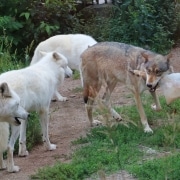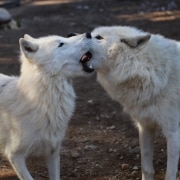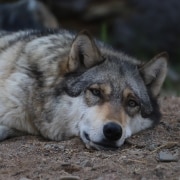Many across the country are probably ready for fall weather. Boltz would second that emotion. It has been a hot, buggy summer, but there his hope in the cool night air that extends into the morning wolf checks. This morning, we had a great visit with Boltz, giving a full body scratch. There should be a video clip of this in Friday’s Youtube posting (I am trying to get back to a weekly post). Today, at the Noon Enrichment program, Boltz managed to claim the deer leg Popsicle provided by wolf care staff. This was a definite change in attitude. We look forward to the fall season and how Boltz’s lack of concern for flying insects brings his focus back to a place in the male rank order. Thanks to Katelyn Schwab, that was able to find a space at the window during the popular Noon Enrichment program and capture this photo.
For years, we have known that Aidan has a sensitive immune system. After Maya died, he lost all the pigmentation in his nose and a tissue biopsy revealed he had discoid lupus. As he overcame the loss of Maya and welcomed Luna and Boltz to the social group, his symptoms subsided and he attempted to pair-bond with Luna. Due to Luna’s circumstances, that was challenging at times, but still provided a socially functioning pack. After the introduction of the 2016 pups and Luna’s behavioral aggression, Aidan had another pack change. Luna was retired and Aidan bonded with the pups and led the pack on his own. He did a great job, but without the support of the dominant female, stress was noticeable. By 2017, mast cell tumors formed on Aidan that required 3 surgeries for removal including one in February 2019. Based on our vet’s experience with dogs, reformation of these growths can be random. For some they keep coming back until they become a systemic issue, for other cases, 3 surgeries for removal and they don’t reappear. We didn’t know how Aidan’s growths would progress, but we had a great spring, until Luna’s issue occurred. On July 6th, Luna and Aidan’s worlds changed. Luna’s was identified with a possible abscess, so we moved her into her own enclosure while we treated with antibiotics. After limited success with the antibiotics, we scheduled her for surgery on the 17th of July and discovered the more serious diagnosis of cancer. The decision to separate coincided with a return of Aidan’s mast cell growth. Just because there was a correlation doesn’t mean causation, but based on his history with auto immune issues after pack changing events, we are working on treating him medically as well as psychologically. After Luna’s incision heals, we plan to reunite the retired pack and give them the social interactions that can keep them distracted as they try to heal their respective issues.
Staff have commented on how Grizzer has changed since Luna’s separation. Certainly having less food competition is always a bonus, especially for a 15-year old wolf with cataracts. Grizzer is far more social with staff (also a competition issue when Luna wanted attention), but more notable is Grizzer’s sleeping proximity to Aidan. The bond between these two individuals remains strong and Grizzer seems to be aware of Aidan’s health issues. Where younger wolves may see health issues as a weakness, older animals seem to more tolerant. Maybe there’s some empathy involved (certainly something we are looking forward to studying next summer with Dr. Matheus Silveira and the 2020 pups.) Grizzer is doing great, he is healthy and having no issues. He had some issues a few years ago with an ACL injury, but the use of Turmeric seems to be helpful. He hadn’t had a pain pill or anti-inflammatory in over a year. We also continue to give him a milk thistle capsule every morning to help with liver functions.
When working with a wolf that has such a challenging diagnosis, staff must be extremely diligent and be aware of every movement, behavioral actions, change in attitude, feeding preferences and assessment of discomfort and pain. Staff need to employ a significant amount of creativity to make sure she gets the necessary medications. She continues to receive two different types of antibiotics, some pain relief and anti-inflammatory medication. The incision has been challenging as the mass continues to cause her irritation and she’s scratched open a portion of the outer sutures. The inner sutures are holding and staff are using topical treatments to keep the incision dry and encourage healing. We have moved her back into the Pack Holding Area and given her access to the Wolf Care Center, but the negative conditioning associated with the surgery recovery has left her reluctant to come into the building. Staff left one of her favorite fleece blankets in the building to entice her, but, she chose to move the blanket outside and sleep in the vestibule or her favorite spot is in the den. A Youtube showing her behavioral activity will be posted later this week and we will connect with Luna as part of our August 14th, Positive Conditioning Webinar. We will definitely need some positive conditioning to overcome Luna’s avoidance from all the medications and procedures surrounding this diagnosis.
The initial results indicate a spindle cell sarcoma that has a deep root behind her left shoulder blade. We are waiting for the full biopsy to understand the full nature of this sarcoma. Please trust that we are working diligently to get her the medication to help her heal from the surgery and be comfortable as we continue to assess and monitor progression. Our August 14th Wolf Care Webinar will have more details.
Denali is still in the Exhibit Pack. He is noticeably slower but can still give a good chase when food is involved. He seems to benefit from the body work treatment that Wolf Care staff gives him daily. There is tension between Grayson and Denali, which can often be traced back to food. Denali defends much of the food with Grayson not always being confident enough to get any, but staff always make sure there is extra food on a daily basis to meet the needs of Grayson and Boltz. Denali’s next challenge is Axel’s continual testing behavior. In this week’s photo, you will see a Jaw Spar, with Axel nearly encompassing not only Denali’s jaw, but his entire muzzle.
Boltz has lost much of his winter confidence as summer bug season has arrived. Wolf care staff are working on ways to desensitize him to flying insects – often using flavored bubbles – but in the high temps of the last few weeks it has been a challenge to keep him visible and interacting with the rest of the pack. We started leaving the medical pen open 24 hours a day. This area is well shaded, has a concrete pad that will remain cool and is adjacent to the water hoses and misting system. The Curator has a ring camera that connects to her phone and she can track Boltz’s midnight rendevous in the medical pen.
Grizzer is doing well for being over 15 years old. He has finally shed his winter coat and rests in the shade. Retirement has a new mister system to help keep him cool, but he has figured out a south wind will send the Exhibit Pack misters right into the shared fenceline. This image was taken in late May, what a difference a month makes. One other noteworthy item is that Grizzer weighed in at 120 pounds in June. This is a very solid weight for a 15 year old wolf coming out of a long, cold winter.

The International Wolf Center uses science-based education to teach and inspire the world about wolves, their ecology, and the wolf-human relationship.










